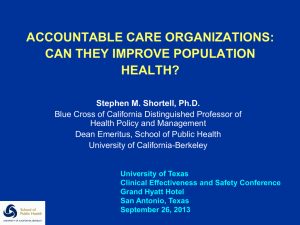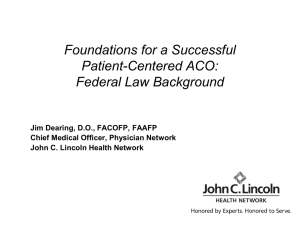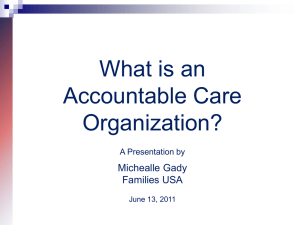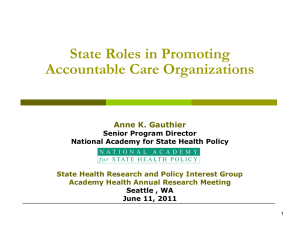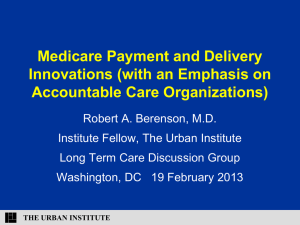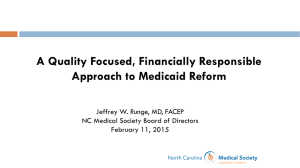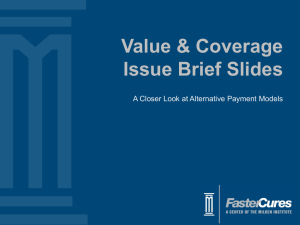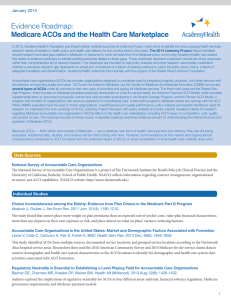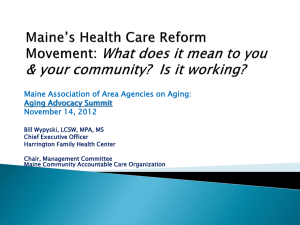Accountable Care Organizations: An AHA Research
advertisement
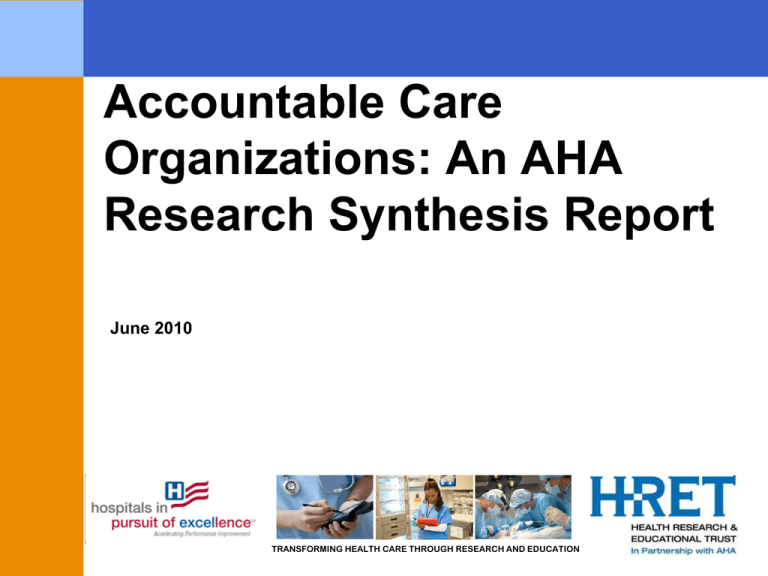
Accountable Care Organizations: An AHA Research Synthesis Report June 2010 TRANSFORMING HEALTH CARE THROUGH RESEARCH AND EDUCATION Accountable Care Organizations: An AHA Research Synthesis Report Accountable Care Organizations: An AHA Research Synthesis Report. Chicago, IL: American Hospital Association Committee on Research, June 2010. Access at http://www.hret.org/accountable/index.shtml. 2 • What is an Accountable Care Organization? • Distinguishing Between ACOs and Earlier Care Delivery Initiatives • ACOs and Health Care Reform • Potential Impacts of ACOs • Key Questions to Consider 3 What is an Accountable Care Organization? • General definition • A partnership among health care providers to coordinate and deliver efficient care • Assumes joint accountability for improving quality and slowing cost growth • The PPACA Section 3022 definition • Organization of health care providers that agrees to be accountable for quality, cost and overall care of Medicare beneficiaries who are enrolled in traditional fee-for-service program and who are assigned to it • For each 12-month period, participating ACOs that meet specified quality performance standards eligible to receive share of any savings if actual per capita expenditures for assigned Medicare beneficiaries are sufficient percentage below specified benchmark amount 4 ACO Envisions Integrated Care Hospital Other Healthcare Providers Payers Patients Specialists 5 Primary Care Providers ACOs vs. Earlier Delivery Models • ACOs and PCMHs • Both models promote the use of enhanced resources (e.g., EHRs, patient registries) • PCMHs do not offer explicit incentives for providers to work collaboratively to reduce costs/improve quality • PCMH model calls for primary care providers to take responsibility for coordinating care • ACOs and HMOs • ACOs have greater variability in types of payment and risk arrangements 6 Key Questions to Consider • • • • • • 7 What are the key competencies required of ACOs? How will ACOs address physician barriers to integration? What are the legal and regulatory barriers to effective ACO implementation? How can ACOs maintain patient satisfaction and engagement? How will quality benchmarks be established? How will savings be shared among ACOs? Key Competencies for ACOs • • • • • • • • 8 Leadership Organizational culture of teamwork Relationships with other providers IT infrastructure for population management and care coordination Infrastructure for monitoring, managing and reporting quality Ability to manage financial risk Ability to receive and distribute payments or savings Resources for patient education and support Addressing Physician Barriers to Integration • Challenges • Overcoming physician attitudes favoring autonomy and individual accountability • Making a strong business case for ACO development • Overcoming resistance to capitation and potential penalties related to quality performance • Determining appropriate reimbursement model • Negotiating appropriate use of potential shared savings, e.g., offset revenue decrease resulting from reduction in volume or invest in care management and IT infrastructure 9 Legal and Regulatory Barriers • Sharing financial incentives could place providers at risk for violating federal law • • • • Medicare ban on self-referral Fraud and abuse statutes Anti-Kickback Statute Civil Monetary Penalty law • Antitrust • IRS guidelines for nonprofit institutions • Need to assess and revise existing contracts among providers 10 Patient Satisfaction and Engagement • Patient education necessary so they understand how ACOs will impact their care • Active patient engagement in care as well as understanding of health care costs and importance of efficient care delivery needed since health outcomes depend on patients’ participation in care • Maintain accountability to patients through measuring and reporting on patient experience 11 Establishing Quality Benchmarks • PPACA leaves selection of ACO quality benchmarks to federal health officials • Important to ensure national standardization of quality benchmarks and how they are interpreted and reported • Will also have to be applicable to variety of care providers and care settings that can be included in an ACO • Combination of process, outcome and patient experience measures 12 Distributing ACO Shared Savings Tier 3 Financial Risk: High Mode of Payment: Full or partial capitation and extensive bundled payments. Additional Incentives: Highest level of shared savings and bonuses if per beneficiary spending is below agreed-upon target, but greatest amount of risk if spending is above agreed-upon target. Tier 2 Financial Risk: Moderate Mode of Payment: Fee-for-service, partial capitation, some bundled payments. Additional Incentives: More shared savings and bonuses if per beneficiary spending is below agreed-upon target, but also some risk if spending is above agreed-upon target. Tier 1 Financial Risk: Low Mode of Payment: Fee-for-service Additional Incentives: Some shared savings and bonuses if per beneficiary spending is below agreed-upon target. S.M. Shortell, L.P. Casalino, and E.S. Fisher, “How the Center for Medicare and Medicaid Innovation Should Test Accountable Care Organizations,” Health Affairs 29, no. 7 (2010): 1293-98. 13 Key References • • • • • • 14 Fisher, E.S., Staiger, D.O., Bynum, J. and Gottlieb, D.J. (2006) Creating Accountable Care Organizations: The Extended Hospital Medical Staff. Health Affairs (26: w44-w57). Fisher, E., McClellan, M., Bertko, J., Lieberman, S., Lee, J., Lewis, J. and Skinner, J. (2009) Fostering Accountable Health Care: Moving Forward in Medicare. Health Affairs (Web exclusive). S.M. Shortell, L.P. Casalino, and E.S. Fisher, “How the Center for Medicare and Medicaid Innovation Should Test Accountable Care Organizations,” Health Affairs 29, no. 7 (2010): 1293-98. Miller, H. (2009) How to Create Accountable Care Organizations. Center for Healthcare Quality and Payment Reform. MedPAC (2009) Report to the Congress: Improving Incentives in the Medicare Program. Chapter 2. Devers, K. and Berenson, R. (2009) Can Accountable Care Organizations Improve the Value of Health Care by Solving the Cost and Quality Quandaries? Robert Wood Johnson Foundation.
